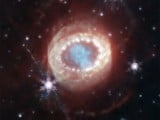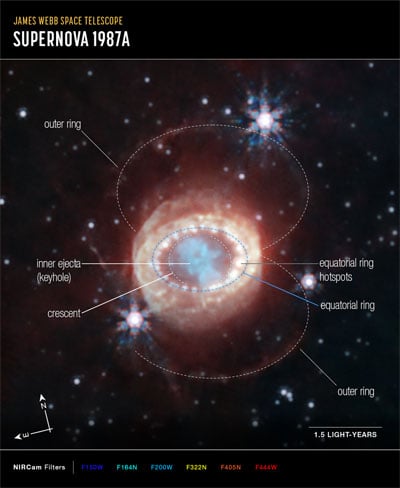

Washington: Astronomers studying the supernova 168,000 light-years away have made new discoveries about the inner shell of the supernova. This information may help solve more mysteries about the explosion of stars.
Supernova SN 1987a, discovered in 1987, has been studied by scientists for the past three decades.
A supernova is the powerful explosion that occurs at the end of a star’s life.
According to NASA, the latest observations of the central core of the supernova show that this keyhole-like core is filled with dense gas and dust ejected from the explosion.
According to researchers, this ring is so dense that even the modern James Webb Space Telescope cannot see through it, and this is also the reason for its keyhole shape. I come
The surrounding equatorial ring is made of material ejected thousands of years before the supernova. There are also bright hotspots in the crust that were created by shockwave collisions from the supernova.
The supernova was studied for many years by the Hubble Space Telescope and the Spitzer Space Telescope, but the extraordinary capabilities of the James Webb Space Telescope revealed hidden facts that had not been revealed before.
(function(d, s, id){
var js, fjs = d.getElementsByTagName(s)[0];
if (d.getElementById(id)) {return;}
js = d.createElement(s); js.id = id;
js.src = “//connect.facebook.net/en_US/sdk.js#xfbml=1&version=v2.3&appId=770767426360150”;
fjs.parentNode.insertBefore(js, fjs);
}(document, ‘script’, ‘facebook-jssdk’));
(function(d, s, id) {
var js, fjs = d.getElementsByTagName(s)[0];
if (d.getElementById(id)) return;
js = d.createElement(s); js.id = id;
js.src = “//connect.facebook.net/en_GB/sdk.js#xfbml=1&version=v2.7”;
fjs.parentNode.insertBefore(js, fjs);
}(document, ‘script’, ‘facebook-jssdk’));



